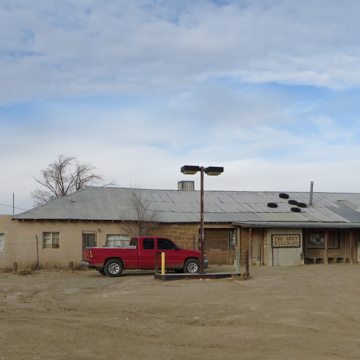The Two Grey Hills Trading Post is one of a handful of traditional Navajo trading posts still in operation. Established in 1897 in a tent, the post gradually expanded as business increased and revenue could be spared to construct additions and new buildings. Historic Navajo trading posts are only rarely noted for their visual appeal, but what they lack aesthetically is more than made up for by the history embedded in their architecture. The main building at Two Grey Hills includes adobe and log walls dating from the turn of the nineteenth century, along with a number of subsequent building episodes that have enlarged the building. The roof includes hipped, shed, and flat sections that reveal the post’s evolution. Also on the 7.3-acre site are a guest hogan, mobile homes, sheds, and corrals.
A traditional Navajo trading post can be described as a store that offers general merchandise to a mainly Diné clientele and which buys the commodities that its clients produce. In years past, there were many trading posts across the Navajo Reservation. The traders operated a network of exchange based on credit that enabled the Diné to support themselves with seasonal commodities such as wool, hides and pelts, and piñon nuts. The posts offered a variety of services and made items such as sugar, coffee, and flour locally available at a time when roads were primitive or nonexistent. Many traders have also sought to expand the market for Diné weaving and jewelry. Between 1915 and 1925, Ed Davies at Two Grey Hills and George Bloomfield at the nearby Toadlena Trading Post encouraged the development of the Two Grey Hills style, one of the most famous of all Diné weaving styles. In the “rug room,” a vault-like room found in many trading post interiors, the Two Grey Hills Trading Post displays many beautiful objects, but the principal attractions are the rugs woven locally in natural, undyed wool, the hallmark of the Two Grey Hills style.
References
Berkholz, Richard C. Old Trading Posts of the Four Corners. Lake City, CO: Western Reflections Publishing Company, 2007.
Kelley, Klara B., and Harris Francis. Navajoland Trading Post Encyclopedia. Window Rock, AZ: Navajo Nation Historic Preservation Division, 2018.
McNitt, Frank. The Indian Traders. Norman: University of Oklahoma Press, 1962.
Spears Architects, AIA. Historic Trading Posts of Northwest New Mexico. Santa Fe: New Mexico Historic Preservation Division, 1993.
Sze, Corinne P., “Two Grey Hills Trading Post,” San Juan County, New Mexico. New Mexico State Register of Cultural Properties Inventory–Nomination Form, 1989. New Mexico State Historic Preservation Division.
Wilson, Les. Personal communication with Lillian Makeda, December 21, 2015.





